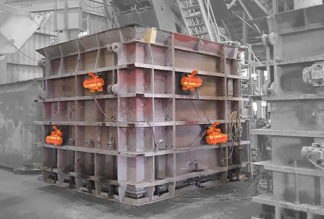Presented as lighter in weight and easier to transfer from one form to another than comparable models, the U1-1600 High Frequency Electric Vibrator delivers the force required to minimize voids and provide a smooth surface finish in precast concrete. With greater equipment reliability and service life, product engineers note, the competitively priced vibrator offers quality, durability and reduced cost of ownership.
|
|
| The U1-1600 is made in America and comparably priced with imported concrete form vibrators, Martin Engineering notes. |
 |
“Surface voids are usually found on vertical casts as a result of entrapped air or water,” notes Martin Engineering Vibration Product Specialist Larry Horrie. “Using a powerful high-speed vibrator to expose these bubbles improves material consolidation for exceptional strength and a flawless finish.”
Constructed with lightweight materials, the U1-1600 weighs 23 lbs. as compared with other precast concrete vibrators on the market averaging 35 lbs. Using standard mounting brackets, Martin Engineering notes, operators with several vibrators affixed to a form have found the U1-1600 easily replaces heavier units and offers a longer equipment life with less cumulative weight. The design also makes the unit more portable; using the easy-grip handle attachment, it can be quickly swapped between multiple forms. With male/female wedge brackets, the vibrator slides snugly into a V-shaped slot specially designed to withstand heavy forces.
The U1-1600 provides 1,799 lbs. of force from a 115-volt (12 amp) electric rotary motor running at 9,000 rpm. Triple dipped and shock-resistant class F windings are designed to operate under high internal temperatures for the sustained periods required in precast concrete production. A long 3-prong power cord features a switch box for overload current protection. Oversized ball bearings that carry the high frequency vibration are lubricated for life and protected from abrasion and wear due to the unit’s tight seal construction. Designed with an aluminum housing and durable O-rings between the end caps, the motor’s internal workings are protected from dust and water, even during pressure washing.
“Vibration speed is a big factor in precast concrete,” Horrie observes. “Without the higher frequency, water and air bubbles aren’t adequately driven to the surface, which can require extra labor to treat and may affect the structural integrity of the cast over the long term.”
In most cases, after the cast leaves the form there is a need for manual touchup, as bugholes are typically revealed only after the concrete sets. The more prevalent the small holes on the surface, generally less than 1 in. in size, the more labor is required to fix them. By using a high rpm portable vibrator, operators can extract bubbles from anywhere in the form, resulting in considerably less finishing labor. — Martin Engineering, Neponset, Ill., 800/544-2947; www.martin-eng.com
